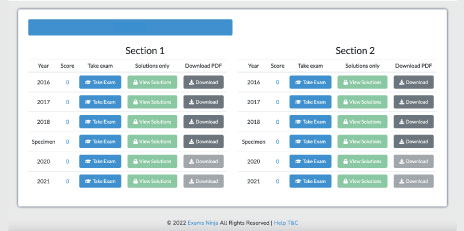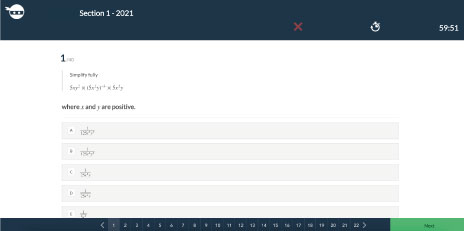PAT Past Paper Collection (2006 - 2023)
Are you looking for PAT past papers? You’ve come to the right place!
- Access every past paper from the PAT in one place.
- Download them to your device or access them on PAT.Ninja for free.
- Explore tonnes of extra content, including sample solutions and examiner reports.
Modern PAT Past Papers (2017 - 2023)
- PAT 2017 Sample Paper
- PAT 2017 Paper
- PAT 2018 Paper
- PAT 2019 Paper
- PAT 2020 Paper
- PAT 2021 Paper
- PAT 2022 Paper
- PAT 2023 Paper
You can access all of these past papers and all of their answers, plus over 900 practice questions when you sign up for a free PAT.ninja account!
Original PAT Past Papers (2006 - 2016)
- PAT 2006 Paper
- PAT 2007 Paper
- PAT 2008 Paper
- PAT 2009 Paper
- PAT 2010 Paper
- PAT 2011 Paper
- PAT 2012 Paper
- PAT 2013 Paper
- PAT 2014 Paper
- PAT 2015 Paper
- PAT 2016 Paper
Practice your PAT skills with over 900 practice questions, all free to access when you sign up to PAT.Ninja.
PAT Sample Solutions
- PAT 2009 Sample Solutions
- PAT 2010 Sample Solutions
- PAT 2019 Sample Solutions
You can access tonnes of fuly worked solutions for the PAT when you upgrade your PAT.Ninja account today!
PAT Examiner Reports (2006 - 2021)
- PAT 2006 Examiner Report
- PAT 2007 Examiner Report
- PAT 2008 Examiner Report
- PAT 2009 Examiner Report
- PAT 2010 Examiner Report
- PAT 2011 Examiner Report
- PAT 2012 Examiner Report
- PAT 2013 Examiner Report
- PAT 2014 Examiner Report
- PAT 2015 Examiner Report
- PAT 2016 Examiner Report
- PAT 2017 Examiner Report
- PAT 2018 Examiner Report
- PAT 2019 Examiner Report
- PAT 2020 Examiner Report
- PAT 2021 Examiner Report
Learn even more about the PAT when you Upgrade your PAT.Ninja account. We have a massive collection of tutorials covering the whole PAT Syllabus!
Why use Past Papers?
Past papers are inherently the most realistic materials available for PAT preparation, as they are real papers from the exam! Past papers are the best way of taking mock exams, as they will provide you with actual PAT questions and a realistic format.
Once you’ve been preparing for a while, you’re more than likely going to want to give the exam a go, which is exactly why past papers are so helpful. Oxford, unfortunately, do not make the mark schemes for these papers available publicly, although they have released a selection of worked solutions which we highly recommend you view.
However, you will be able to see the answers for each paper when using PAT.Ninja, as we have every past paper available to take and make for free. Plus, you can go a step further and view worked solutions for every paper to get a better understanding of how each question is solved. You can access these when you upgrade your account!
History of the PAT
The PAT dates back as far as 2006 and is used by the University of Oxford for a number of physics-based courses. Since the first exam, the format of the PAT has changed a great deal, meaning that older past papers will look very different from the version of the PAT you’ll be sitting this year. In the initial 2006 past paper, we can see the following format for the PAT:
- The PAT was originally split into two papers, titled “Physics” and “Mathematics for Physics”. Each paper would last 1 hour.
- The first paper was split into three sections: multiple-choice questions (10 questions for 10 marks), written answers (3 questions for 20 marks) and long question (1 question split into 6 parts for 20 marks)
- Paper 2 consisted of 12 written maths questions totalling to 50 marks spread unevenly across the questions.
- Any type of calculator was allowed for the first paper, while no calculators were allowed for the second.
So essentially, this version of the test was a lot more structured than modern PAT papers. Calculators were banned and the order of the sections was swapped in 2008, but no major changes to the format were made until 2017:
- The two-section format of the PAT was scrapped in favour of one large section with 23 questions worth 100 marks.
- The exam begins with multiple choice 12 multiple-choice questions, each worth 2 marks.
- The remaining questions are individual written questions worth a varying amount of marks.
- In subsequent exams, the number of questions on the paper was not consistent, ranging between 23 and 27.
- In 2018, calculators were once again introduced but were required to be basic calculators that meet the PAT standards.
It’s worth noting that the PAT Syllabus has not been updated since 2018, meaning no new content knowledge has been added to the exam. We recommend reading the Examiner Reports from each year to gain a better insight of how applicants fared.
PAT Past Paper Tips
Here are a few tips and tricks to help you optimise your PAT Preparation with these past papers:
- Ensure that you’ve used the PAT Syllabus as much as possible when revising, as this document details literally everything you need to know. It’s important to know this by heart so you don’t miss any topics or revise something that won’t be covered in the exam.
- These past papers are a great way of understanding the PAT format and question types, so you should look through one towards the start of your preparation. That way, you’ll have a better understanding of the actual exam and will have some context to work with when revising.
- The older past papers have plenty of questions that will help in your preparation, but be aware that the format of these papers aren’t representative of the exam as it’s currently made.
- Don’t rush through all the past papers at once! You’ve got a lot to go through, but you should save most of them for later on in your revision schedule. The ideal strategy is to build up your content knowledge and try some practice questions first. Once you’re more confident in your abilities, you will have a good chance of doing well in the past papers.
- The PAT is typically taken on paper, so you may want to print off your past papers for a more authentic experience. Just be aware that you will then need to set up your own timer.
- You’re allowed a calculator in the PAT, but you should still aim to only use it when absolutely necessary. You’re only going to be allowed a basic one anyway, so you’re going to have to do most of the complex calculations yourself.
- Be as strict as possible with yourself when it comes to sticking with exam conditions. There are no cheats in the real exam, so push through and do as well as you can when practising. Anything that goes wrong here can be improved afterwards!
- Marking will be tricky for the PAT as the mark schemes aren’t available for most papers. However, you can access the answers to these questions for free with PAT.Ninja or upgrade your account to go through worked solutions.
Here on Exams.Ninja, you’ll find amazingly in-depth guides to show you through every section of the exam, along with guides to help you with your planning and revision. Check out one of our Definitive Guides below!
Get the most out of your PAT Past Papers with PAT.Ninja
Your PAT.Ninja account gives you access to every PAT past paper and tonnes of practice questions. You can even upgrade your account to access worked solutions and other amazing features. To access your past papers, just follow these simple steps:
STEP 1
Sign up for your free Exams.Ninja account.

STEP 2
Enter the Exam Arena on the home page.

STEP 3
Choose the past paper that you want to try.

STEP 4
Take the exam!

Sign up today to try the PAT Preparation Platform for free!


